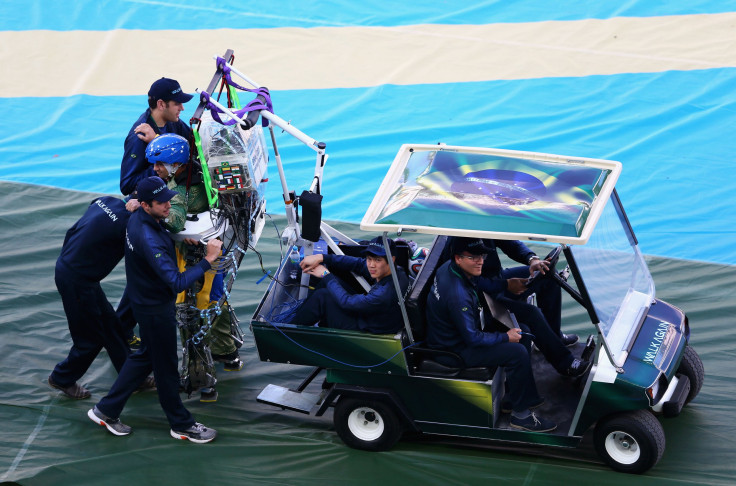
A 29-year-old paraplegic man, who is completely paralyzed from the waist down, completed the symbolic first kick of the 2014 World Cup inside the Corinthians Arena in Sao Paolo, Brazil.
The man who volunteered his body for the experiment is Juliano Pinto. Pinto took his historic steps and “kick” thanks to a robotic exoskeleton suit created by Brazilian neuroscientist Dr. Miguel Nicolelis and his team of over 150 researchers.
The robotic exoskeleton suit, which those on twitter have been calling the “Iron Man” suit, uses a cap that is places on top of the patient’s head. It then neurologically transmits brain signals to the computer located in the back of the exoskeleton. The computer than decodes the signals and sends them to the robotic legs which then allows the suit to move. The “Iron Man” suit is powered by hydraulics and allows the wearer of the suit to feel like they are actually moving for themselves rather than the robotic suit simply carrying their body for them. The suits battery life can exceed over two hours of use.
"The basic idea is that we are recording from the brain and then that signal is being translated into commands for the robot to start moving," Dr Gordon Cheng, at the Technical University of Munich, who is a member of the team, told BBC.
Dr, Chen is in charge of the artificial skin that is currently being developed for the exoskeleton. The skin, which is made of flexible printed circuit boards, each contains, temperature, pressure and speed sensors.
The artificial skin is then placed on the soles of the feet of the patient and allows them to receive the same simulation of walking. When the brain tells the exoskeleton to move, signals are transmitted to an electronic vibration device on the patient’s arms and legs, stimulating their skin.
Over time, the brain naturally associates the sensations on the arms and legs with the movement of the suit. Over time, the patient’s brain will actually believe they have legs and are walking.
After the symbolic kick-off, Dr. Nicolelis tweeted:
We did it!!!!
— Miguel Nicolelis (@MiguelNicolelis) June 12, 2014Over eight volunteers trained in the lab with the “Iron Man” suit, but ultimately it was Juliano who was chosen to wear the suit live in front of the world.
It was up to Juliano to wear the exoskeleton, but all of them that shot. It was a big score by these people and by our science,” he said.
Dr. Nicolelis does his research at Duke University in North Carolina, and is the leading expert in brain-machine interfaces. His work first garnered recognition in 2003, when he published a report showing that monkeys could control the movement of virtual arms using their own brain activity.
Dr. Nicolelis’s researchers and scientists are currently working under the Walk Again Project. The Walk Again project released a statement stating the demonstration at the World Cup was just the beginning of a future, “in which people with paralysis may abandon a wheelchair and literally walk again.”
The suit is being called, Bra-Santos Dumont, which combines the three letters for Brazil, and Alberto Santos-Dumont, the Brazilian aviation pioneer who was born in the southern state of Minas Gerais.
In case you were wondering why you didn’t see this event live on your coverage of the 2014 World Cup Opening Ceremony, many television networks chose not to show the event, which quickly prompted much criticism throughout the social media universe.
#FIFA is to blame for the poor historic moment coverage of the #exoskeleton | #exoesqueleto #BRAvsCRO #WorldCup2014 http://t.co/NG4vt8hGHI
— Nemo (@LeNautilus) June 13, 2014While TV networks may have chosen not to air this historic event, they did give us plenty of J-Lo, Pitbull and Claudia Leitte as they performed their “hit” song, “We Are One.”
© 2025 Latin Times. All rights reserved. Do not reproduce without permission.



